量子化学卷一答案
量子化学与光谱学考试试题

量子化学与光谱学考试试题(本文采用正文形式回复,按照试题要求书写)量子化学与光谱学考试试题一、选择题1. 以下哪个不属于光谱学的研究对象?A. 紫外光谱B. 红外光谱C. 带宽光谱D. 核磁共振光谱2. 量子力学给出了分子光谱现象的理论解释,以下哪个不是量子化学的基本原理?A. 波粒二象性B. 波函数C. 量子态D. 洪特规则3. 下列哪个过程可以用于确定分子的能级?A. 哈利斯法B. 能量传递法C. 积分法D. 激光脉冲法4. 以下哪个量子数不属于动量量子数?A. nB. lC. mD. s5. 分子光谱学是指研究分子在电磁辐射下吸收、发射、散射等现象的学科,以下哪个光谱方法属于分子光谱学的研究内容?A. 偏振光谱B. 色散光谱C. 荧光光谱D. 微波光谱二、简答题1. 请简述量子化学在光谱学中的作用。
量子化学是研究微观粒子(如原子、分子等)的行为及其相互作用的学科,通过量子力学理论分析和计算,可以解释和预测分子在电磁辐射下的光谱行为。
它提供了分子的能级计算、波函数计算和能量传递等方面的基础理论,为解释和分析光谱现象提供了重要的方法和工具。
2. 请介绍一种常用的光谱学分析方法,并描述其基本原理。
紫外-可见光谱法是一种常用的光谱学分析方法。
它利用物质在紫外和可见光谱范围内吸收电磁辐射的特性来分析物质的组成和结构。
其基本原理是当电磁波通过样品时,会与样品中的物质相互作用,产生吸收、反射或透射等现象。
通过测量样品对特定波长(或频率)光的吸收程度,可以推断样品中所含物质的特性和浓度。
三、分析题1. 通过紫外-可见吸收光谱,我们可以研究物质的能带结构。
请详细描述如何通过吸收光谱得到物质的能带结构信息,并结合具体实例进行说明。
吸收光谱是指测量物质对光的吸收强度随波长变化的规律。
通过紫外-可见吸收光谱,我们可以获取物质的能带结构信息。
具体步骤如下:首先,选取合适的样品,并制备样品溶液或固体样品。
其次,将样品置于光谱仪器中,选择适当的波长范围进行测量。
量子化学考试试题
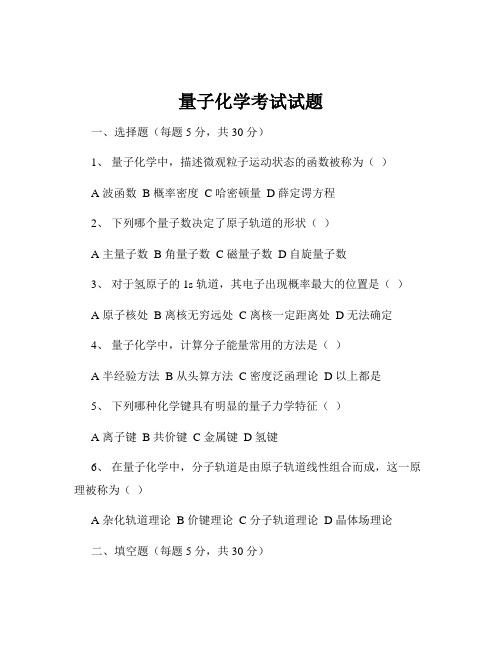
量子化学考试试题一、选择题(每题 5 分,共 30 分)1、量子化学中,描述微观粒子运动状态的函数被称为()A 波函数B 概率密度C 哈密顿量D 薛定谔方程2、下列哪个量子数决定了原子轨道的形状()A 主量子数B 角量子数C 磁量子数D 自旋量子数3、对于氢原子的 1s 轨道,其电子出现概率最大的位置是()A 原子核处B 离核无穷远处C 离核一定距离处D 无法确定4、量子化学中,计算分子能量常用的方法是()A 半经验方法B 从头算方法C 密度泛函理论D 以上都是5、下列哪种化学键具有明显的量子力学特征()A 离子键B 共价键C 金属键D 氢键6、在量子化学中,分子轨道是由原子轨道线性组合而成,这一原理被称为()A 杂化轨道理论B 价键理论C 分子轨道理论D 晶体场理论二、填空题(每题 5 分,共 30 分)1、量子力学的基本假设包括波函数假设、算符假设、测量假设、全同性原理和__________________ 。
2、氢原子的薛定谔方程在球坐标下的解中,径向波函数 R(r) 与__________________ 有关。
3、多电子原子的电子排布遵循的原则有能量最低原理、泡利不相容原理和__________________ 。
4、分子的偶极矩是衡量分子__________________ 的物理量。
5、密度泛函理论的核心思想是将体系的能量表示为__________________ 的泛函。
6、量子化学计算中,常用的基组有 STO-3G、6-31G 等,其中 6-31G 表示的是__________________ 。
三、简答题(每题 10 分,共 20 分)1、简述量子化学中 HartreeFock 方法的基本思想。
2、解释为什么分子的振动光谱通常具有一系列的吸收峰,而不是单一的吸收峰。
四、计算题(共 20 分)已知氢原子处于某一激发态的波函数为:ψ =1/√8π a₀³(r/a₀) exp(r/2a₀) ,其中 a₀为玻尔半径。
基础量子化学练习定稿版

基础量子化学练习精编W O R D版IBM system office room 【A0816H-A0912AAAHH-GX8Q8-GNTHHJ8】2010基础量子化学练习(1)一、 判断正误( )1、 一个态函数总是等于时间的函数乘以坐标的函数。
( )2、 态函数总是Hamiltonian 算符的本征函数。
( )3、 Hamiltonian 算符的本征函数的任意线性组合是Hamiltonian 算符的本征函数。
( )4、 如果态函数不是算符ˆA的本征函数,则性质A 的一次测量可给出一个不是ˆA 的本征值的值。
( )5、 几率密度与时间无关。
( )6、 如果两个算符具有共同的本征函数,那么这两个算符可对易。
( )7、 算符ˆx 与d i dx -可对易。
( )8、 氢原子Hamiltonian 算符的束缚态的本征函数构成完备集。
( )9、 厄米算符的本征函数是正交的。
( )10、 描述电子轨道运动的波函数必须是奇函数。
二、已知:2ˆˆˆ,A d dx B x ==,计算2ˆˆˆˆ,()A B A B ⎡⎤+⎣⎦及 三、已知:11223344ˆˆˆˆ,,,,A a A b A a A d ϕϕϕϕϕϕϕϕ====如果任意状态可以表示为12343253,ψϕϕϕϕ=+++那么当我们对该状态进行测量时,获得a 和d 的几率各是多少?求任意状态 的性质A 的平均值。
2010基础量子化学练习(2)一、 判断正误( )11、 算符ˆˆˆ,,A B C 满足ˆˆˆˆ,0,,0A B A C ⎡⎤⎡⎤==⎣⎦⎣⎦,则三个算符存在共同的本征函数集。
( )12、 不能对易的算符不可能具有共同的本征函数。
( )13、 当对本征态的性质A 进行测量时,能够得到的唯一仅有的值是算符ˆA的本征值。
( )14、 如果一个算符的平方等于单位算符,那么这个算符的本征值等于+1或者-1。
( )15、 所有品优的奇函数和偶函数都是宇称算符的本征函数。
量子化学习题解(仅供参考)
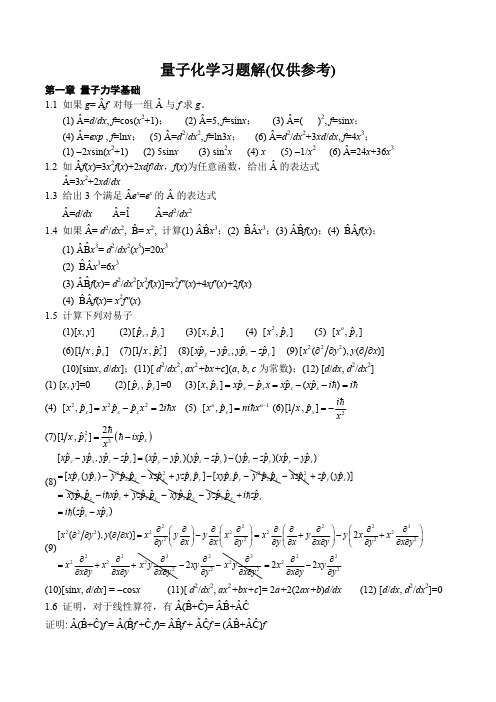
ˆ ÂB ˆ BÂ= ˆ ˆ ÂB) ˆ = [B, ˆ Â] 证明:(1) [Â, B]= (BÂ (2)[Âm,Ân]= ÂmÂnÂnÂm= Âm+nÂm+n=0 ˆ BÂ ˆ 2 ˆ Â2B (3) [Â2, B]= ˆ ÂBÂ+ ˆ ˆ BÂ ˆ 2= Â2B ˆ BÂ ˆ 2 ˆ ˆ ˆ BÂ)+ ˆ ˆ BÂ)Â ˆ ÂBÂ Â[Â, B]+[Â, B]Â= Â(ÂB (ÂB = Â2B ˆ Â[Â, B]+[Â, ˆ ˆ [Â2, B]= B]Â ˆ Ĉ]]+ [B, ˆ [Ĉ, Â]]+ [Ĉ, [Â, B]] ˆ (4) [Â, [B, ˆ ĈĈB)]+[ ˆ ˆ (ĈÂÂĈ)]+ [Ĉ, (ÂB ˆ BÂ)] ˆ =[Â, (B B, ˆ ĈÂĈB ˆ B ˆ ĈÂ+ĈBÂ+ ˆ B ˆ ĈÂBÂ ˆ Ĉ ĈÂB+ ˆ ÂĈB+ ˆ ĈÂB ˆ ĈBÂ ˆ ÂB ˆ Ĉ+BÂ ˆ Ĉ=0 = ÂB ˆ p ˆ 2 2m V ( x ) , 分别计算(1)当 V(x)=V(常数), (2)当 V(x)=kx2/2, (3)当 V(x) V(r)=e2/40r 1.9 H
(12) [d/dx, d2/dx2]=0
1.7 如果 Â 是线性算符,b,c 为常数,f, g 为任意函数,证明 Â(bf+cg)= bÂf + cÂg;证明若 Â(bf+cg)= bÂf + cÂg,则 Â 一定是线性算符。 1)证明: Â 是线性算符 Â(bf+cg)= Â(bf) + Â(cg) = bÂf + cÂg 2)证明: Â(bf+cg)= bÂf + cÂg b,c 为常数
量子化学期末考试及答案
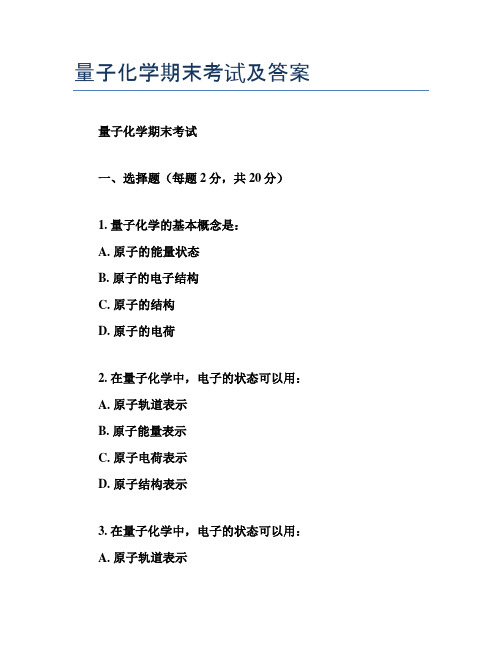
量子化学期末考试及答案量子化学期末考试一、选择题(每题2分,共20分)1. 量子化学的基本概念是:A. 原子的能量状态B. 原子的电子结构C. 原子的结构D. 原子的电荷2. 在量子化学中,电子的状态可以用:A. 原子轨道表示B. 原子能量表示C. 原子电荷表示D. 原子结构表示3. 在量子化学中,电子的状态可以用:A. 原子轨道表示B. 原子能量表示C. 原子电荷表示D. 原子结构表示4. 在量子化学中,电子的状态可以用:A. 原子轨道表示B. 原子能量表示C. 原子电荷表示D. 原子结构表示5. 在量子化学中,电子的状态可以用:A. 原子轨道表示B. 原子能量表示C. 原子电荷表示D. 原子结构表示二、填空题(每题2分,共20分)1. 量子化学的基本原理是____________。
答:量子力学。
2. 量子化学中,电子的状态可以用____________表示。
答:原子轨道。
3. 量子化学中,电子的能量可以用____________表示。
答:原子能量。
4. 量子化学中,电子的电荷可以用____________表示。
答:原子电荷。
5. 量子化学中,电子的结构可以用____________表示。
答:原子结构。
三、论述题(每题10分,共30分)1. 请简要介绍量子化学的基本原理。
答:量子化学是一门研究原子和分子的科学,它基于量子力学的原理,用来描述原子和分子的结构和性质。
量子力学的基本原理是,电子的运动是由量子态决定的,而不是由经典物理学的运动方程决定的。
量子力学的基本原理是,电子的运动是由量子态决定的,而不是由经典物理学的运动方程决定的。
量子力学还提出了一种新的概念,即电子的状态可以用原子轨道、原子能量、原子电荷和原子结构等表示。
量子力学的基本原理是,电子的运动是由量子态决定的,而不是由经典物理学的运动方程决定的。
2. 请简要介绍量子化学的应用。
答:量子化学的应用非常广泛,它可以用来研究原子和分子的结构和性质,以及它们之间的相互作用。
应化所量子化学考试题库及其答案详解
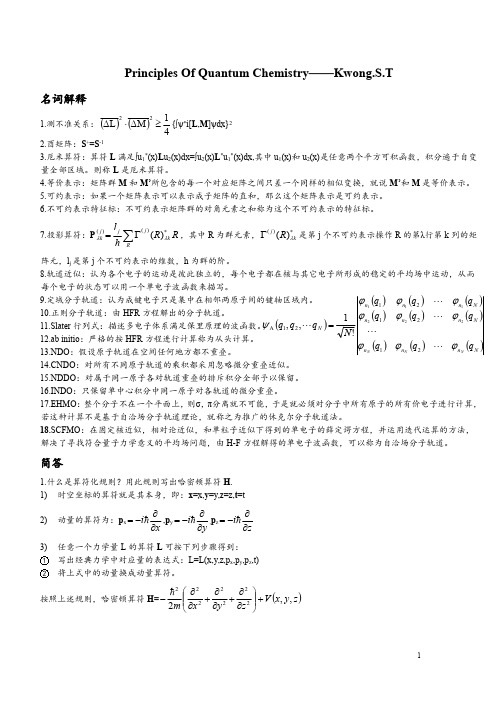
Principles Of Quantum Chemistry——Kwong.S.T名词解释1.测不准关系:()()41M L 22≥∆⋅∆{∫ψ*i[L ,M ]ψdx}22.酉矩阵:S +=S -13.厄米算符:算符L 满足∫u 1*(x)L u 2(x)dx=∫u 2(x)L *u 1*(x)dx,其中u 1(x)和u 2(x)是任意两个平方可积函数,积分遍于自变量全部区域。
则称L 是厄米算符。
4.等价表示:矩阵群M 和M’所包含的每一个对应矩阵之间只差一个同样的相似变换,就说M’和M 是等价表示。
5.可约表示:如果一个矩阵表示可以表示成子矩阵的直和,那么这个矩阵表示是可约表示。
6.不可约表示特征标:不可约表示矩阵群的对角元素之和称为这个不可约表示的特征标。
7.投影算符:P R R hl k j Rj j k*∑Γ=λλ)()()(,其中R 为群元素,*Γk j R λ)()(是第j 个不可约表示操作R 的第λ行第k 列的矩阵元,l j 是第j 个不可约表示的维数,h 为群的阶。
8.轨道近似:认为各个电子的运动是彼此独立的,每个电子都在核与其它电子所形成的稳定的平均场中运动,从而每个电子的状态可以用一个单电子波函数来描写。
9.定域分子轨道:认为成键电子只是集中在相邻两原子间的键轴区域内。
10.正则分子轨道:由HFR 方程解出的分子轨道。
11.Slater 行列式:描述多电子体系满足保里原理的波函数。
12.ab initio :严格的按HFR 方程进行计算称为从头计算。
13.NDO :假设原子轨道在空间任何地方都不重叠。
DO :对所有不同原子轨道的乘积都采用忽略微分重叠近似。
15.NDDO :对属于同一原子各对轨道重叠的排斥积分全部予以保留。
16.INDO :只保留单中心积分中同一原子对各轨道的微分重叠。
17.EHMO :整个分子不在一个平面上,则σ,π分离就不可能,于是就必须对分子中所有原子的所有价电子进行计算,若这种计算不是基于自洽场分子轨道理论,就称之为推广的休克尔分子轨道法。
量子化学试题及答案
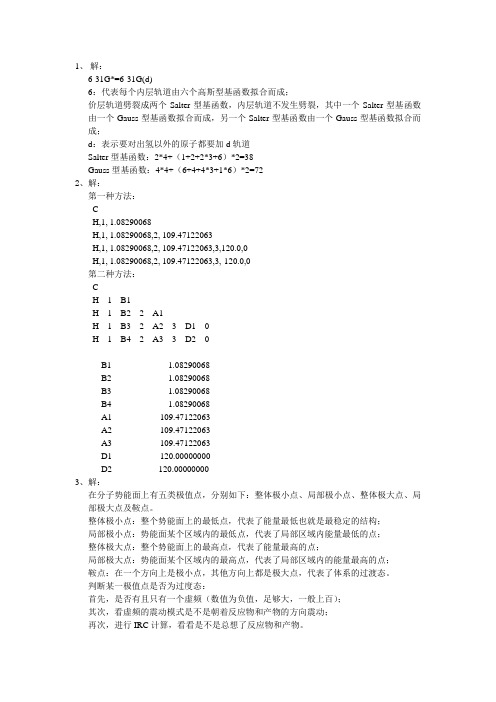
6-31G*=6-31G(d)6:代表每个内层轨道由六个高斯型基函数拟合而成;价层轨道劈裂成两个Salter型基函数,内层轨道不发生劈裂,其中一个Salter型基函数由一个Gauss型基函数拟合而成,另一个Salter型基函数由一个Gauss型基函数拟合而成;d:表示要对出氢以外的原子都要加d轨道Salter型基函数:2*4+(1+2+2*3+6)*2=38Gauss型基函数:4*4+(6+4+4*3+1*6)*2=722、解:第一种方法:CH,1, 1.08290068H,1, 1.08290068,2, 109.47122063H,1, 1.08290068,2, 109.47122063,3,120.0,0H,1, 1.08290068,2, 109.47122063,3,-120.0,0第二种方法:CH 1 B1H 1 B2 2 A1H 1 B3 2 A2 3 D1 0H 1 B4 2 A3 3 D2 0B1 1.08290068B2 1.08290068B3 1.08290068B4 1.08290068A1 109.47122063A2 109.47122063A3 109.47122063D1 120.00000000D2 -120.000000003、解:在分子势能面上有五类极值点,分别如下:整体极小点、局部极小点、整体极大点、局部极大点及鞍点。
整体极小点:整个势能面上的最低点,代表了能量最低也就是最稳定的结构;局部极小点:势能面某个区域内的最低点,代表了局部区域内能量最低的点;整体极大点:整个势能面上的最高点,代表了能量最高的点;局部极大点:势能面某个区域内的最高点,代表了局部区域内的能量最高的点;鞍点:在一个方向上是极小点,其他方向上都是极大点,代表了体系的过渡态。
判断某一极值点是否为过度态:首先,是否有且只有一个虚频(数值为负值,足够大,一般上百);其次,看虚频的震动模式是不是朝着反应物和产物的方向震动;再次,进行IRC计算,看看是不是总想了反应物和产物。
量子考试题及答案
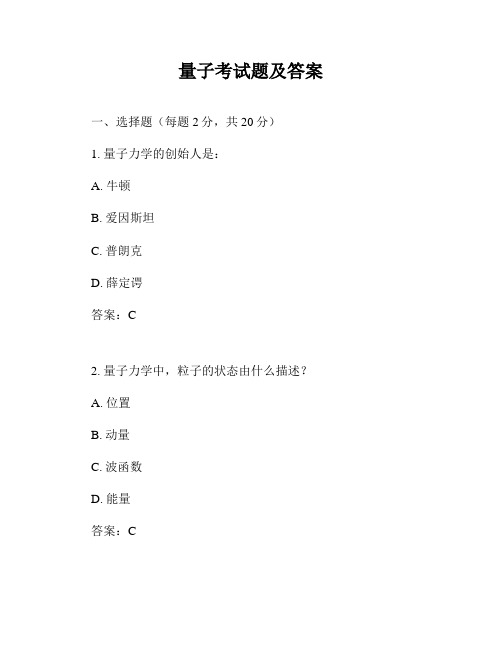
量子考试题及答案一、选择题(每题2分,共20分)1. 量子力学的创始人是:A. 牛顿B. 爱因斯坦C. 普朗克D. 薛定谔答案:C2. 量子力学中,粒子的状态由什么描述?A. 位置B. 动量C. 波函数D. 能量答案:C3. 海森堡不确定性原理表明:A. 粒子的位置和动量可以同时准确测量B. 粒子的位置和动量不能同时准确测量C. 粒子的位置和能量可以同时准确测量D. 粒子的动量和能量可以同时准确测量答案:B4. 量子力学中的泡利不相容原理适用于:A. 电子B. 质子C. 中子D. 所有基本粒子答案:A5. 量子纠缠是指:A. 两个粒子之间的经典相互作用B. 两个粒子之间的量子相互作用C. 两个粒子之间的引力相互作用D. 两个粒子之间的电磁相互作用答案:B6. 量子力学中的薛定谔方程是一个:A. 线性方程B. 非线性方程C. 微分方程D. 代数方程答案:C7. 量子力学中的隧道效应是:A. 粒子通过势垒的概率不为零B. 粒子通过势垒的概率为零C. 粒子通过势垒的概率为一D. 粒子通过势垒的概率为负答案:A8. 量子力学中的叠加态是指:A. 粒子同时处于多个状态B. 粒子只处于一个状态C. 粒子处于确定的状态D. 粒子处于随机的状态答案:A9. 量子力学中的测量问题涉及:A. 粒子的测量结果B. 粒子的测量过程C. 粒子的测量设备D. 粒子的测量结果和过程答案:D10. 量子力学中的退相干是指:A. 量子态的相干性消失B. 量子态的相干性增强C. 量子态的相干性不变D. 量子态的相干性随机变化答案:A二、填空题(每题2分,共20分)1. 量子力学中的波粒二象性表明,粒子既表现出______的性质,也表现出______的性质。
答案:波动;粒子2. 量子力学中的德布罗意波长公式为:λ = ______ / p,其中λ表示波长,p表示动量。
答案:h / p3. 量子力学中的能级是______的,这是由量子力学的______决定的。
量子化学习题及答案
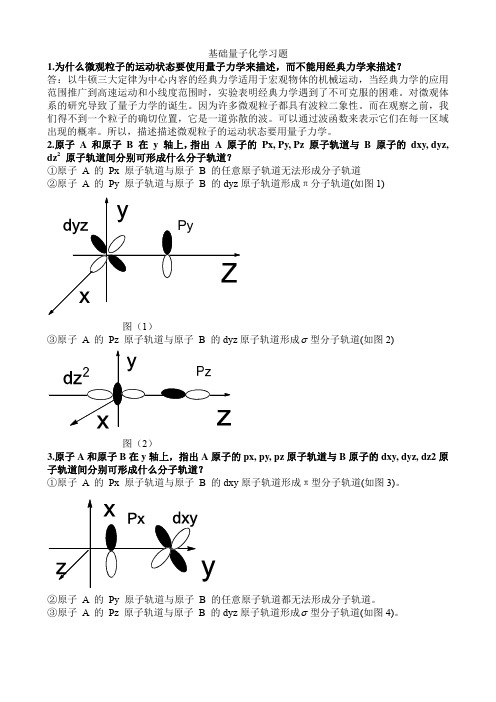
1 2 1 Z 1 ˆ 有能量算得: H i 2 i a rai 2 i j i rij i
ˆ 在电子近似下可得到: H
i
H
2
eff
( ri , i , i )
0 0 2
0 0 e2
①
因为C 2 H 4 的分子轨道情况是兼并的,所以 e1
由①可得到
e
0 1
ei
2
12
e1 S12
2
e10 Δ12 0 可解出 e1 1 S12
12 ei S12 c1i 0 ② 0 ei c 2 i e2
ˆ ,若存在任意归一化的品优波函数 ,则有 (1)对于给定体系的哈密顿算符 H
ˆ d E 此式被称为变分积分。其中 为变分函数,E 0 为 H ˆ 的最低本征值,即体系 E *H
0
ˆ 关于 的平均能量 E 必是体系基态能量E 0 的上限,这就是变分 基态能量。体系哈密顿算符 H
原理。 (2)在量子化学计算中,广泛采用的是线性变分函数,它是满足体系边界条件的 m 个 线性无关的函数 1 , 2 ,…… m 的线性组合: c11 c 2 2 c3 3 c m m 这里常用实 函数作为变分函数。采用线性变分函数的变分法通常称线性变分法。 15. 使用分子轨道理论求乙烯分子、2-丁烯分子的成键分子轨道能级 e1 和分子轨道波函数
基础量子化学习题 1.为什么微观粒子的运动状态要使用量子力学来描述,而不能用经典力学来描述? 答:以牛顿三大定律为中心内容的经典力学适用于宏观物体的机械运动,当经典力学的应用 范围推广到高速运动和小线度范围时,实验表明经典力学遇到了不可克服的困难。对微观体 系的研究导致了量子力学的诞生。因为许多微观粒子都具有波粒二象性。而在观察之前,我 们得不到一个粒子的确切位置,它是一道弥散的波。可以通过波函数来表示它们在每一区域 出现的概率。所以,描述描述微观粒子的运动状态要用量子力学。 2.原子 A 和原子 B 在 y 轴上, 指出 A 原子的 Px, Py, Pz 原子轨道与 B 原子的 dxy, dyz, 2 dz 原子轨道间分别可形成什么分子轨道? ①原子 A 的 Px 原子轨道与原子 B 的任意原子轨道无法形成分子轨道 ②原子 A 的 Py 原子轨道与原子 B 的 dyz 原子轨道形成π分子轨道(如图 1)
量子化学试题及答案
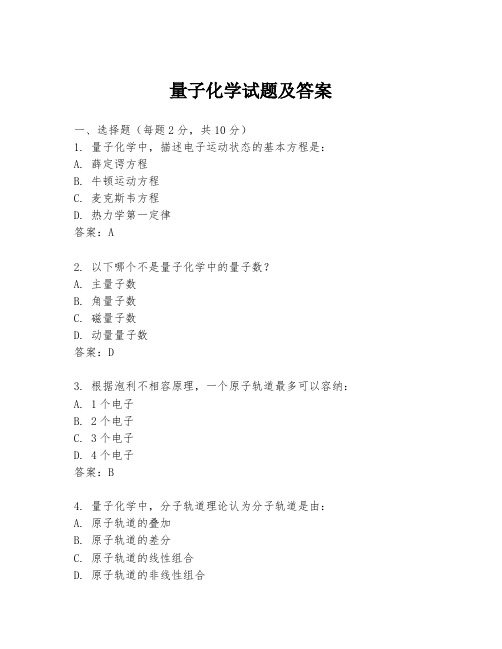
量子化学试题及答案一、选择题(每题2分,共10分)1. 量子化学中,描述电子运动状态的基本方程是:A. 薛定谔方程B. 牛顿运动方程C. 麦克斯韦方程D. 热力学第一定律答案:A2. 以下哪个不是量子化学中的量子数?A. 主量子数B. 角量子数C. 磁量子数D. 动量量子数答案:D3. 根据泡利不相容原理,一个原子轨道最多可以容纳:A. 1个电子B. 2个电子C. 3个电子D. 4个电子答案:B4. 量子化学中,分子轨道理论认为分子轨道是由:A. 原子轨道的叠加B. 原子轨道的差分C. 原子轨道的线性组合D. 原子轨道的非线性组合答案:C5. 以下哪个不是量子化学中的波函数?A. 波恩-奥本海默近似B. 哈密顿算符C. 原子轨道D. 分子轨道答案:B二、填空题(每题2分,共10分)1. 量子化学中,电子的波动性可以通过______方程来描述。
答案:薛定谔2. 根据量子化学理论,原子轨道的能级是由______量子数决定的。
答案:主3. 量子化学中,分子的电子云分布可以通过______轨道理论来分析。
答案:分子轨道4. 量子化学中,电子的自旋量子数可以取值为______。
答案:±1/25. 量子化学中,原子轨道的径向分布函数通常用______来表示。
答案:R(r)三、简答题(每题5分,共20分)1. 简述量子化学中波函数的物理意义。
答案:波函数是量子化学中描述电子状态的数学函数,它包含了电子在空间中出现的概率分布信息。
2. 解释量子化学中量子数的作用。
答案:量子数是量子化学中用来描述电子在原子轨道中运动状态的一组整数或半整数,包括主量子数、角量子数、磁量子数和自旋量子数,它们决定了电子的能量、角动量和自旋状态。
3. 描述量子化学中分子轨道理论的基本原理。
答案:分子轨道理论是基于量子力学的基本原理,认为分子轨道是由原子轨道的线性组合形成的,分子轨道的形成可以解释分子的化学性质和稳定性。
4. 量子化学中,如何理解电子的波粒二象性?答案:电子的波粒二象性是指电子既可以表现出粒子的性质,如在原子中占据特定的轨道,也可以表现出波动的性质,如干涉和衍射现象。
量子化学课程习题及标准答案
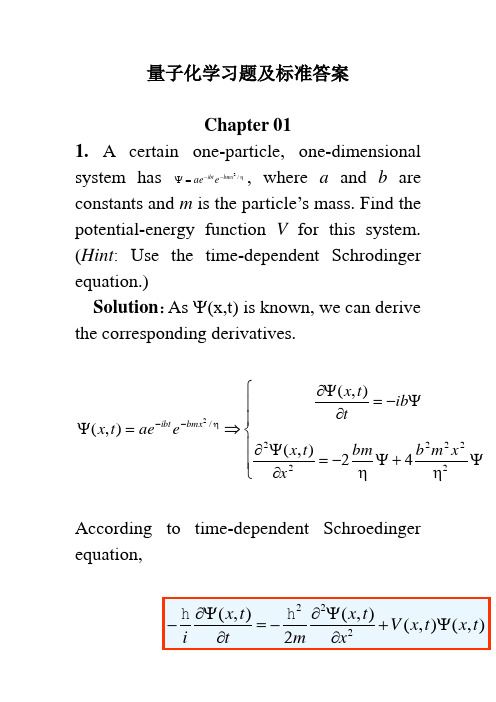
量子化学习题及标准答案Chapter 011. A certain one-particle, one-dimensional system has η/2bmx ibt e ae --=ψ, where a and b are constants and m is the particle ’s mass. Find the potential-energy function V for this system. (Hint : Use the time-dependent Schrodinger equation.)Solution :As ψ(x,t) is known, we can derive the corresponding derivatives.⎪⎪⎩⎪⎪⎨⎧ψ+ψ-=∂ψ∂ψ-=∂ψ∂⇒=ψ--222222/42),(),(),(2ηηηx m b bm xt x ib t t x e ae t x bmx ibtAccording to time-dependent Schroedinger equation,substituting into the derivatives, we get222),(mx b t x V =2. At a certain instant of time, a one-particle, one-dimensional system has bx xe b /||2/13)/2(-=ψ, where b = 3.000 nm. If a measurement of x is made at this time in the system, find the probability that the result (a) lies between 0.9000 nm and 0.9001 nm (treat this interval as infinitesimal); (b) lies between 0 and 2 nm (use the table of integrals, if necessary). (c) For what value of x is the probability density a minimum? (There is no need to use calculus to answer this.) (d) Verify that ψ is normalized.Solution :a) The probability of finding an particle in a space between x and x+dx is given by6/223210*29.32--==ψ=dx e x b dx P b x b) 0753.02910*20/223==⎰--dx e x bP b x c) Clearly, the minimum of probability density is at x=0, where the probability densityvanishes. d)4220/223/223/2232===ψ=⎰⎰⎰⎰+∞-+∞∞--+∞∞--+∞∞-dxe x b dx e x b dx e x b dx P b x b x b x3. A one-particle, one-dimensional system has the state function2222/4/16/4/12)/32)((cos )/2)((sin c x c x xe c at e c at --+=ψππ where a is a constant and c = 2.000 Å. If the particle ’s position is measured at t = 0, estimate the probability that the result will lie between 2.000 Å and 2.001 Å.Solution :when t=0, the wavefunction is simplified as441610*158.2)32(),(22--==ψc x xe c t x πChapter 021. Consider an electron in a one-dimensional box of length2.000Å with the left end of the box at x = 0. (a) Suppose we have one million of these systems, each in the n = 1 state, and we measure the x coordinate of the electron in each system. About how many times will the electron be found between 0.600 Å and 0.601 Å? Consider the interval to be infinitesimal. Hint: Check whether your calculator is set to degrees or radians. (b) Suppose we have a large number of these systems, each in the n =1 state, and we measure the x coordinate of the electron in each system and find the electron between 0.700 Å and 0.701 Å in 126 of the measurements. In about how many measurements will the electron be found between 1.000 Å and 1.001 Å?Solution: a) In a 1D box, the energy and wave-function of a micro-system are given by)sin(2,22222x ln l ml n E πψπ==η therefore, the probability density of finding the electron between 0.600 and 0.601 Å is65510*545.6)(sin 242⇒==-dx x ln l P πb) From the definition of probability, the probability of finding an electron between x and x+dx is given bydx x l n l P )(sin 22π= As the number of measurements of finding the electron between 0.700 and 0.701 Å is known, the number of system is1(sin 22*158712158712001.0)7.02*1(sin 2212612622=⇒===πP P N2. When a particle of mass 9.1*10-28 g in a certain one-dimensional box goes from the n = 5 level to the n = 2 level, it emits a photon of frequency 6.0*1014 s -1. Find the length of thebox.Solution.lml h n n ml n n E lowerup lowerup 36222222222110*26646.18)(2)(-=-=-=∆ηπ3. An electron in a stationary state of a one-dimensional box of length 0.300 nm emits a photon of frequency 5.05*1015 s -1. Find the initial and final quantum numbers for this transition.Solution:2,388)(2)(22222222222===-⇒=-=-=∆lower upper lower up lower up lower up n n n n hv ml h n n ml n n E ηπ4. For the particle in a one-dimensional box of length l , we could have put the coordinate origin at the center of the box. Find the wave functions and energy levels for this choice of origin.Solution: The wavefunction for a particle in a one-dimernsional box can be written as)2()2()(x mE BSin x mE ACos x ηη+=ψ If the coordinate origin is defined at the center of the box, the boundary conditions are given as2()22(0)(2()22(0)(22mE BSin l mE ACos x mE BSin l mE ACos x l x lx +⇒=-⇒==-=ηηηηψψ Combining Eq1 with Eq2, we get)4(,0)22()3(,0)22(Eq l mE BSin Eq l mE ACos ==ηη Eq3 leads to A=0, or )22(l mE Cos η=0. We willdiscuss both situations in the following section.If A=0, B must be non-zero number otherwise the wavefunction vanishes.2220)22(02mlh n E n l mE l mE Sin B π=⇒=⇒=⇒≠ηηIf A ≠08)12()21(220)22(00)22(0)22(0222mlh n E n l mE l mE Cos B l mE Sin l mE Cos A ψπ⇒+=⇒+=⇒==⇒≠⇒=⇒≠ηηηη5. For an electron in a certain rectangular well with a depth of 20.0 eV , the lowest energy lies 3.00 eV above the bottom of the well. Find the width of this well. Hint : Use tanθ = sin θ/cos θ Solution : For the particle in a certain rectangular well, the E fulfill with )2sin()2()2cos()(21010l mE V E l mE E E V ---=-ηη Substituting into the V and E, we get1010011110*64.22)7954.0(7954.022)(2)2()2()2(-----=⇒+-=⇒+-=⇒-=--==lowest l mEn l n l mE V E E E V l mE Tan l mE Cos l mE Sin ππηηηηηChapter 031. If Aˆf (x ) = 3x 2 f (x ) + 2xd f /dx , give an expression for Aˆ. Solution :Extracting f(x) from the known equation leads to the expression of Adx d x x A 23ˆ2+=2. (a) Show that (Aˆ+B ˆ)2 = (B ˆ+A ˆ)2 for any two operators. (b) Under what conditions is (Aˆ+B ˆ)2 equal to Aˆ2+2A ˆB ˆ+B ˆ2? Solution: a)2222ˆ()ˆˆ)(ˆˆ(ˆˆˆˆˆˆˆˆˆˆˆ)ˆˆ)(ˆˆ()ˆˆ(B A B A BA B A A B B A B B A A B A B A B A =++=+++=+++=++=+ b) B AA B A B B A A B A ˆˆ2ˆˆˆˆˆˆˆ)ˆˆ(2222++=+++=+If and only if A and B commute, (Aˆ+B ˆ)2 equals to Aˆ2+2A ˆB ˆ+B ˆ2 3. If Aˆ = d 2/dx 2 and B ˆ = x 2, find (a) A ˆB ˆx 3; (b) B ˆA ˆx 3; (c) A ˆB ˆf (x ); (d)B ˆA ˆf (x )Solution: a)3522320ˆˆxx dxd x B A == b)3322236ˆˆx x dxd x x A B == c))()(4)(2)]()(2[)]([)(ˆˆ2222222x f dxd x x f dx d x x f x f dxd x x xf dx d x f x dx d x f B A ++=+==d))()()(ˆˆ222222x f dxd x x f dx d x x f A B ==4. Classify these operators as linear or nonlinear: (a) 3x 2d 2/dx 2; (b) ( )2; (c) ∫ dx ; (d) exp; (e) ∑=n x 1.Solution:Linear operator is subject to the following condition.f A c cf Ag A f A g f A ˆ)(ˆˆˆ)(ˆ=+=+ a) Linearb) Nonlinear c) Linear d) Nonlinear e) Linear5. The Laplace transform operator Lˆ isdefined by⎰∞-=0)()(ˆdx x f e x f L px(a) Is Lˆ linear? (b) Evaluate Lˆ(1). (c)Evaluate Lˆe ax , assuming that p >a . Solution:a) L is a linear operator b)0,1)1(ˆ0>==⎰∞-p p dx e L px c)pdx e dx e e e L x a p ax px ax ===⎰⎰∞--∞-)(ˆ0)(06. We define the translation operator hT ˆ by hT ˆf (x ) = f (x + h ). (a) Is hT ˆ a linear operator? (b) Evaluate (2ˆ3ˆ121+-T T )x 2. Solution:a) The translation operator is linear operator b)2212212121(2ˆ3ˆ)2ˆ3ˆ(x x x T x T x T T +=+-=+-7. Evaluate the commutators (a) [xˆ,xp ˆ]; (b) [xˆ,2ˆxp ]; (c) [x ˆ,yp ˆ]; (d) [x ˆ, ),,(ˆz y x V ]; (e) [x ˆ,H ˆ]; (f) [z yx ˆˆˆ, 2ˆxp ]. Solution: a)ηηηi xx x x i x x i p xx =∂∂--∂∂-=∂∂-=)ˆ1ˆ(],ˆ[]ˆ,ˆ[b)xp i p p x p x p p xx x x x x x∂∂==+=222ˆ2)ˆ]ˆ,ˆ[]ˆ,ˆ[ˆ(]ˆ,ˆ[ηηc)0)ˆˆ(],ˆ[]ˆ,ˆ[=∂∂-∂∂-=∂∂-=yx y x i y x i p xy ηηd)0ˆ),,(ˆ),,(ˆˆ)],,(ˆ,ˆ[=-=x z y x V z y x V x z y x V xe)mxT x V T x H x ==+=21,ˆ[]ˆ,ˆ[]ˆˆ,ˆ[]ˆ,ˆ[f)xz y p z y xx∂∂=ˆˆ2]ˆ,ˆˆˆ[22ηChapter 041:The one-dimensional harmonic-oscillator is at its first excited state and its wavefunction is given as)21exp()()(2)(24/14/31x x x βπβψ-=please evaluate the expectation values(average values) of kinetic energy (T), potential energy (V) and the total energy.Answer: 1) First of all, check the normalization property of the wavefunction.2) Evaluate the expectation value of kinetic energy.3) Evaluate the expectation value ofpotential energy4) Total Energy = T + V2. The one-dimensional harmonic-oscillator Hamiltonian is2222ˆ22ˆˆxm v mp H xπ+= The raising and lowering operators for thisproblem are defined as]ˆ2ˆ[)2(1ˆ2/1x ivm p m A x π+=+, ]ˆ2ˆ[)2(1ˆ2/1x ivm p m A x π-=-Show thathv H A A 21ˆˆˆ-=-+,hv H A A 21ˆˆˆ+=+-, hv A A-=-+]ˆ,ˆ[ ++=A hv A H ˆ]ˆ,ˆ[, ---=A hv A Hˆ]ˆ,ˆ[ Show that +Aˆ and -A ˆ are indeed ladder operators and that the eigenvalues are spaced at intervals of hv . Since both the kinetic energy and the potential energy are nonnegative, we expect the energy eigenvalues to be nonnegative. Hence there must be a state of minimum energy. Operate on the wavefunction for this state first with -Aˆ and then with +Aˆ and show that the lowest energy eigenvalue ishv 21. Finally, conclude that hvn E )21(+=, n = 0, 1, 2, …Answer:1) Write down the definition of operatordx di px η-=ˆ2) Expand the operators in full form.]2[21]2[2122ˆ222222vmxi dx di mA vmxi dx d i mA mx v dx d m H πππ--=+-=+-=-+ηηη 3) Evaluate the corresponding combination ofoperators4242[21]22][2[21ˆ4222[21]2[2]2[2[21]2[21]22[ˆ21ˆ2122]4222[21]]2[2]2[[21]2[21]2[2121ˆ2122]42[21]4222[21]]2[2]2[[21]2[21]2[21322222222333222222332222222333222222222222222222222222222222222222222222222v dx d ix v dx d i mx v mxi v dxd m i m mx v dx d m vmxi dx d i mH A v dx d i mx v dx d ix v dx d i v dxd m i m vmxi dx d i mx v vmxi dx d i dxd m m vmxi dx d i mmx v dx d m A H hv H hv mx v dx d m x m v dxd vmx dx d x vm vm dx d m vmxi dxd i vmxi vmxi dx d i dx d i m vmxi dx d i mvmxi dx d i m A A hv H hv mx v dx d m x m v vm dxd m x m v dxd vmx dx d x vm vm dx d m vmxi dxd i vmxi vmxi dx d i dx d i m vmxi dx d i mvmxi dx d i m A A πππππππππππππππππππππππππππππππππππππ+---=+-+-=+---=+-++--=+-+-=+=++-=+-++-=+--+--=+---=-=-+-=+--=++---=--+---=--+-=+++--+ηηηηηηηηηηηηηηηηηηηηηηηηηηηηηηηηηηηηη+++=+-=+-=+-=-hvA vmxi m dx d i m hv vmxi m hv dxd i m hv mxi v dx d i v m H A A H ]22121[]221[]21[]42[21ˆˆ222ππππηηηηIn the same manner, we can get---=-hvA H A A H ˆˆ 4) Substituting the above communicators into the Schroeidnger equation, we getψψψψψψψψψψψψ------++++++-=-=-=+=+=+==A hv E hvA E A hvA H A A H A hv E hvA E A hvA H A A H E H)(]ˆ[ˆ)(]ˆ[ˆˆThis shows that +Aˆ and -A ˆ are indeed ladder operators and that the eigenvalues are spaced at intervals of hv .5) Suppose that ψ is the eigenfunction with the lowest eigenvalue. ψψlowest E H =ˆAccording to the definition of A_ operator, we haveψψ---=A hv E A H )(ˆAs ψ is the eigenfunction with the lowest eigenvalue, the above equation is fulfilled if and only if 0=-ψAOperating on the wave function for this statefirst with -A ˆ and then with +A ˆ leads to ψψψψhv H hv H A A 21ˆ]21ˆ[0=⇒-==-+Therefore, the lowest energy is 1/2 hv.Λ3,2,1,0,)(21ˆ=+=n hv n H ψψChapter 051. For the ground state of the one-dimensional harmonic oscillator, compute the standard deviations ∆x and ∆p x and check that the uncertainty principle is obeyed.Answer:1) The ground state wavefunction of the one-dimensional harmonic oscillator is given by2214141)(x e ααπψ--=2) The standard deviations ∆x and ∆p x are defined as222x x x -=∆2 2)2∆=∆-(p(p∆)pThe product of ∆x and ∆p is given by2422122ηηη==•=∆∆ααp xIt shows that the uncertainty principle is obeyed.2. (a) Show that the three commutationrelations [x Lˆ,y L ˆ] = z L i ˆη, [y L ˆ,z L ˆ] = x L i ˆη, [z L ˆ,x L ˆ] = y L i ˆη are equivalent to the single relation L L Lˆˆˆηi =⨯ (b) Find [2ˆx L,y L ˆ] Answer:1): zy x y x z x z y z y x y x x z z y x y y x z x x z y z z y y z x z z y x y z x y x z y x z y x z y x L i L L L i L L L i L L k L j L i L i k L L j L L i L L k L L L L j L L L L i L L L L i L L j L L i L L k L L j L L k L L k L j L i L k L j L i L L L k L j L i L L ηηηρρρηρρρρρρρρρρρρρρρρρρρρρ===⇒++=++=-+-+-=-++--=++⨯++=⨯++=],[],[],[)(],[],[],[)()()()()(ˆˆˆ2):)()()(],[],[],[2x z z x x z z x x y x y x x y x L L L L i L L i L i L L L L L L L L L +=+=+=ηηη3. Calculate the possible angles between L and the z axis for l = 2.Answer:The possible angles between L and the z axis are equivalent the angles between L and L z . Hence, the angles are given by:Lm Cos L z ==+=θηη6)12(2 ︒︒︒︒=7.144,10.114,00.90,91.65,26.35θ4. Complete this equation:m l m l z Y m Y L 333ˆη=Chapter 061. Explain why each of the following integrals must be zero, where the functions are hydrogenlike wave functions: (a) <2p 1|z L ˆ|3p -1>; (b) <3p 0|z L ˆ|3p 0>Answer:Both 3p -1 and 3p 0 are eigenfunctions of L z , with eigenvalues of -1 and 0, respectively. Therefore, the above integrals can be simplified asa) due to orthogonalization properties of eigenfunctions03|213ˆ21111=-=--p p p L p z b) 02. Use parity to find which of the following integrals must be zero: (a) <2s |x |2p x >; (b) <2s |x 2|2p x >; (c) <2p y |x |2p x >. The functions in these integrals are hydrogenlike wave functions.Answer:1) b) and c) must be zero.3. For a hydrogen atom in a p state, the possible outcomes of a measurement of L z are – ħ, 0, and ħ. For each of the following wave functions, give the probabilities of each of these three results: (a)z p 2ψ; (b) y p 2ψ; (c) 12p ψ. Then find <L z > for each of these three wave functions.Answer:a) 022p p z ψψ=, therefore, the probabilities are:0%, 100%, 0% )(2111222-+=p p p x ψψψ, the probabilities are 50%, 0%, 50%.12p ψ,the probabilities are 100%, 0%, 0%b) 0,0,14. A measurement yields 21/2ħ for the magnitude of a particle ’s orbital angular momentum. If L x is now measured, what are the possible outcomes?Answer:1): Since the wavefunction is the eigenfunction of L2, a measurement of the magnitude of the orbital angular momentum should be+L=LLηη(=⇒21)1,The possible outcomes when measure L x are-1, 0, 1Chapter 071. Which of the following operators are Hermitian: d /dx , i (d /dx ), 4d 2/dx 2, i (d 2/d x 2)?Answer :An operator in one-D space is Hermitian if⎰⎰=dx A dx A **)ˆ(ˆψψψψ a)⎰⎰⎰⎰-=-=-=∞∞-dx dx d dx dx d dx dx d dx dx d *****)(ψψψψψψψψψψ b)⎰⎰⎰⎰=-=-=∞∞-dx dx d i dx d i dx dx d i i dx dxd i ****)(ψψψψψψψψψψc)⎰⎰⎰⎰⎰=+-=-=-=∞∞-∞∞-dxdxddxddxddxdxddxddxddxddxddxdxdψψψψψψψψψψψψψ2*22****22*44 444 44This operator can be written as a product of 1D kinetic operator and a constant. Hence, it’s Hermitian.d) As the third operator is Hermitian, this operator is not Hermitian.2. If Aˆand Bˆare Hermitian operators, prove that their product AˆBˆis Hermitian if and only if Aˆand Bˆcommute. (b) If Aˆand Bˆare Hermitian, prove that 1/2(AˆBˆ+BˆAˆ) is Hermitian.(c) Is x p xˆˆHermitian? (d) Is 1/2(x p xˆˆ+x p xˆˆ)Hermitian?Answer:1)If operator A and B commute , we have⎰=-⇒=-⇒=0])ˆˆˆˆ[(0ˆˆˆˆˆˆˆˆˆ*τψψd A B B A A B B A A B B A⎰⎰⎰=⇒=-⇒τψψτψψτψψd A B d B A d A B B A***]ˆˆ[]ˆˆ[0])ˆˆˆˆ[(Operator A and B are Hermitian, we have⎰⎰⎰==⇒τψψτψψτψψd B A d B A d A B ˆˆ)ˆ()ˆ(]ˆˆ[***Therefore, when A and B commute, the following equation fulfills. Namely, AB is also Hermitian.⎰⎰=τψψτψψd B A d B A ˆˆ]ˆˆ[**2)]ˆˆˆˆ[21)]ˆˆˆˆ(21[***⎰⎰⎰+=+τψψτψψτψψd A B d B A d A B B A Operator A and B are Hermitian, we get⎰⎰⎰⎰⎰⎰⎰+=+⇒+=+=+τψψτψψτψψτψψτψψτψψτψψd A B B A d A B B A d B A A B d B A d A B d A B d B A *******])ˆˆˆˆ(21[)ˆˆˆˆ(21])ˆˆˆˆ(21[)ˆˆ()ˆˆ([21]ˆˆˆˆ[21The above equation shows that the operator 1/2[AB+BA] is Hermitian.c) xp x is not Hermitian since both x and px are Hermitian and do not commute.d) YesChapter 081. Apply the variation function cr e -=φto the hydrogen atom; choose the parameter c to minimize the variational integral, and calculate the percent error in the ground-state energy. Solution :1) The requirement of the variation function being a well-behaved function requires that c must be a positive number.2) check the normalization of the variation function.322*)(c d d Sin dr r ed cr πϕθθτφφ==⎰⎰⎰⎰- 3) The variation integral equals to )2(214])2[(2)1(21()121(ˆ32223*32*32*3**-=-∂∂+∂∂-=-∇-=-∇-==⎰⎰⎰⎰⎰⎰--c c c dr r e rr r e c d r c c d r c d d H w cr cr τφφπφπτφφπτφφτφφ4) The minimum of the variation integral is21101-=⇒=⇒=-=∂∂w c c c w5) The percent error in the ground state is 0%2. If the normalized variation function x l 2/13)/3(=φ for 0 ≤ x ≤ l is applied to the particle-in-a-one-dimensional-box problem, one finds that the variation integral equals zero, which is less than the true ground-state energy. What is wrong?Solution:The correct trail variation function must be subject to the same boundary condition of the given problem. For the particle in a 1D box problem, the correct wavefunction must equal to zero at x=0 and x=l. However, the trial variation function x l 2/13)/3(=φ does not fulfill these requirement. The variation integral basedon this incorrect variation function does not make any sense.3. Application of the variation function2cx e -=φ(where c is a variation parameter) to a problem with V = af (x), where a is a positive constant and f (x ) is a certain function of x , gives the variation integral as W = c ħ2/2m +15a /64c 3. Find the minimum value of W for this variation function.Solution: 23434123434141min 4141413272598.03)25(23)25(0)64152(ηηηηm a m a w m a c dc c a m c d c w ==⇒±=⇒=+=∂∂4. In 1971 a paper was published that applied the normalized variation functionN exp(-br 2a 02-cr /a 0) to the hydrogen atom and stated that minimization of the variation integral with respect to the parameters b and c yielded an energy 0.7% above the true ground-state energy for infinite nuclear mass. Without doing any calculations, state why this result must be wrong.Solution:From the evaluation of exercise 1, we know that the variation function exp(-cr) gives no error in the ground state of hydrogen atom. This function is a special case of the normalized variation function N exp(-br 2a 02-cr /a 0) when b equals to zero. Therefore, adopting the normalized variation function as a trial variation function should also have no error in the ground state energy for hydrogen atom.5. Prove that, for a system with anondegenerate ground state, 0*ˆE d H>⎰τφφ, if φ is any normalized, well-behaved function that is not equal to the true ground-state wavefunction. (E 0 is the lowest-energy eigenvalueof Hˆ) Solution:As the eigenfunctions of the Hermitian operator H form a complete set, any well-behaved function which is subject to the same boundary condition can be expanded as a linear combination of the eigenfunction of the Hermitian operator, namely,∑∞==0i i i c ψφ, where ψi s are eigenfunctions of Hermitian operator H, c i s are constant.The expectation value of φ with respect to the Hermitian operator is00201020201020020*00**00*0*0*ˆˆ)(ˆE c E E c E c c E c E c E c c E c cH c c d c H c d H i i i i i i i i i i i i i ij j j j i i i j j i i j j j i i i ==+>+======∑∑∑∑∑∑∑⎰∑∑⎰∑∑⎰∞=∞=∞=∞=∞=∞=∞=∞=∞=∞=∞=δψψτψψτφφChapter 09, 101. For the anharmonic oscillator with Hamiltonian 43222212ˆdx cx kx dx d m H +++-=η, evaluate E (1)for the first excited state, taking the unperturbed system as the harmonic oscillator. Solution:The wavefunction of the first excited state of the harmonic oscillator is241312)4(x xe απαψ-=Hence, the first order correct to energy of the first excited state is given by6213422134134324131'*1415)4()4()4)(()4(ˆ222απαπαπαπαψψαααd dx e x d dx x d e x xe x d x c xe dx H x x x ==•=•+•=---⎰⎰⎰⎰2. Consider the one-particle, one-dimensional system with potential-energyV = V 0 for l x l 4341<<, V = 0 for l x 410≤≤ andl x l ≤≤43and V = ∞ elsewhere, where V 0 = 22/ml η.Treat the system as a perturbed particle in a box. (a) Find the first-order energy correction for the general stationary state with quantum number n . (b) Find the first-order correction to the wave function of the stationary state with quantum number n .Solution:The wavefunction of a particle in 1D box is given by)(2)0(x ln Sin l n πψ= Take this as unperturbed wavefunction, and the perturbation H ’ is given by V .a) The first-order energy correction for ψn is])23[]2[(224]2[4[2)()(2)()(2ˆ00004341)0('*)0()1(πππππππππψψn Sin n Sin n V V n S n Sin l l V dx V x l n Sin x l n Sin l dx x ln VSin x l n Sin l dx H E l ln n -+=-+====⎰⎰⎰b) The first correction to the wavefunction is given by)0()0()0()0()0()1(2)0()0(222)0('(818mn m mn n m n mn n E E H n E E ml hn E ψψψψ∑∞≠-==-⇒=3. For an anharmonic oscillator with3222212ˆcx kx dx d m H ++-=η, take 'ˆHas cx 3. (a) Find E (1) for the state with quantum number v . (b) Find E (2) for the state with quantum number v . You will need the following integral:3,'2/13)0(3)0('2/)1[(3]8/)3)(2)(1[(||++++++>=<v v v v v v v v x αδαψψ3,'2/131,'2/3]8/)2)(1([)2/(3----++v v v v v v v v δαδαSolution: a) As the potential of the unperturbed is a even function, the eigenfunctions of the unperturbed system are either even or odd. The perturbation is an odd function with respect to x. Hence, the first order energy correction is zero.b) The second order energy correction is given by)51212(8]38)2)(1(838)1(338)3)(2)(1([()2(3)21(38)3)(2)(1((''2323333332)0()0(1,2/31,2/33,32)0()0(2)0(3)0()0()0()0()0()0()0()2(++-=--++-++-+++=-+++++++=-=-=∑∑∑∞≠-++∞≠∞≠n n hvc hvn n n hv n hv n hv n n n c E E n n n n n n n c E E cx E E H H E n m mn n n n n n n n m mn m n n m m n m n nm n αααααδαδαδαψψψψψψ4. Calculate the angle that the spin vector S makes with the z axis for an electron with spin function α.Solution:For an electron, both S and S z equal to one half. The magnitude of S isοηη74.54]31[23)1(===+=ArcCos S S S θ 5. (a) Show that 12ˆP and 23ˆP do not commutewith each other. (b) Show that 12ˆPand 23ˆP commute when they are applied to antisymmetric functions.Solution:a) Set the wavefunction to be)1()3()2()2()1()3(321321φφφφφφ≠b) When the function is antisymmetric, we haveψψψψψψψ2312121223231223ˆˆ)(ˆˆˆ)(ˆˆˆP P P P P P P P =-=-==-=-=6. Which of the following functions are (a) symmetric? (b) antisymmetric?(1) )2()1()2()1(ααg f ; (2) )]2()1()2()1()[2()1(αββα-f f ;(3) )3()2()1()3()2()1(βββf f f ; (4) )(21r r a e --;(5) )]1()2()2()1()][2()1()2()1([βαβα--f g g f ; (6) )(21221r r a e r +-. Solution:(2) is antisymmetric(3), (5) and (6) are symmetricChapter 11, 131. How many electrons can be put in each of the following: (a) a shell with principal quantum number n ; (b) a subshell with quantum numbers n and l ; (c) an orbital; (d) a spin-orbital?Solution:a) 2n 2, b) 2*(2l+1), c) 2, d) 12. Give the possible values of the total-angular-momentum quantum number J that result from the addition of angular momentum with quantum numbers (a) 3/2 and 4; (b) 2, 3, and 1/2Solution:Coupling between two angular momentums with quantum number j 1 and j 2 gives the possible quantum number J of the total angular momentum as:2121j j J j j +<<-a) The possible values are 11/2, 9/2, 7/2, 5/2b) The possible values are:11/2, 9/2, 9/2, 7/2, 7/2, 5/2, 5/2, 3/2, 3/2, 1/23. Find the terms that arise from each of the following electron configurations: (a) 1s22s22p63s23p5g; (b) 1s22s22p3p3d(c) 1s22s22p24dSolution:As fully-filled sub-shells do not contribution the total orbital and spin angular momentum, we can ignore the electrons in these sub-shells while considering the atomic terms. Hence, a) The atomic terms can be:3H, 1H, 3G, 1G, 3F, 1Fb) The atomic terms can be:4G, 2G, 4F, 2F, 4D, 2D, 4P, 2P, 4S, 2S4F 2F, 4D, 2D, 4P, 2P4D, 2D, 4P, 2P, 4S, 2Sc) The atomic terms can be:2G, 2F, 2D, 2P, 2S4F, 2F, 4D, 2D, 4P, 2P。
量子化学习题及参考答案
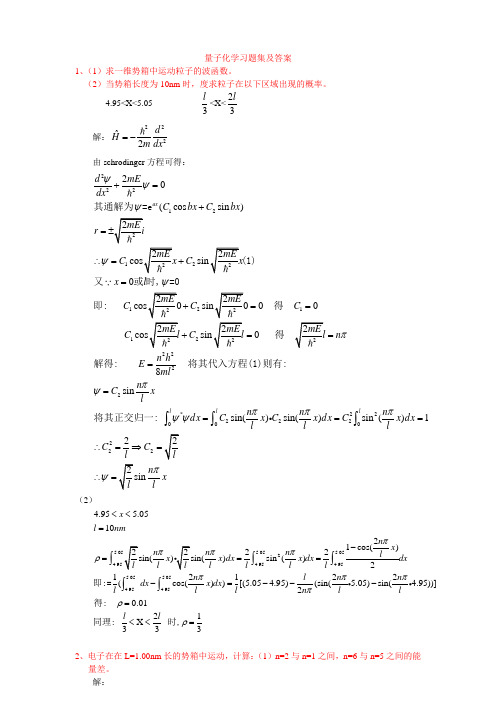
量子化学习题集及答案1、(1)求一维势箱中运动粒子的波函数。
(2)当势箱长度为10nm 时,度求粒子在以下区域出现的概率。
4.95<X<5.053l <X<23l 解:222ˆ2d Hm dx =-由schrodinger 方程可得:2221221222121221222222220(cos sin )222sin0220sin 000222sin08axd mEdxC bx C bxmEr i mEmEC x C x x l mEmEC C C mEmEmEC l C l l n n h E ml ψψψψψπ+=+=∴=+=+==+===其通解为=e (1)又或时,=0即: 得得 解得:将其2*22222000222sin sin()sin()sin ()12l l l n C xln n n dx C x C x dx C x dx l l lC C l n x lπψπππψψπψ====∴=⇒=∴=⎰⎰⎰代入方程(1)则有:将其正交归一: (2)5.05 5.0524.95 4.95 4.955.05 5.054.95 4.954.95 5.051021cos()222)sin()sin ()212122(cos())[(5.05 4.95)(sin( 5.05)sin( 4.95))]2x l nmn x n n n l x x dx x dx dxl l l l l l n l n n dx x dx l l l n l lππππρππππ<<=-===-=---⎰⎰⎰⎰⎰即:=得: 0.0121X 333l l ρρ=<<=同理: 时,2、电子在在L=1.00nm 长的势箱中运动,计算:(1)n=2与n=1之间,n=6与n=5之间的能量差。
解:22212222222182181812222222182181881.001,2213811*********,6651181108110810n h E ml l nm n n h h h E m m m n n h h h E m m m ------====∴=-===∴=-=3、一维势箱(势箱长为0.30nm )中的电子发射一个小频率为5.05×1015S —1,试求其跃迁始态与终态的量子数。
结构化学练习之量子力学基础习题附参考问题详解

量子力学基础习题一、填空题(在题中的空格处填上正确答案)1101、光波粒二象性的关系式为_______________________________________。
1102、德布罗意关系式为____________________;宏观物体的λ值比微观物体的λ值_______________。
1103、在电子衍射实验中,│ψ│2对一个电子来说,代表___________________。
1104、测不准关系是_____________________,它说明了_____________________。
1105、一组正交、归一的波函数ψ1, ψ2, ψ3,…。
正交性的数学表达式为 ,归一性的表达式为 。
1106、│ψ (x 1, y 1, z 1, x 2, y 2, z 2)│2代表______________________。
1107、物理量xp y - yp x 的量子力学算符在直角坐标系中的表达式是_____。
1108、质量为 m 的一个粒子在长为l 的一维势箱中运动,(1)体系哈密顿算符的本征函数集为_______________________________ ;(2)体系的本征值谱为____________________, 最低能量为____________ ;(3)体系处于基态时, 粒子出现在0 ─ l /2间的概率为_______________ ;(4)势箱越长, 其电子从基态向激发态跃迁时吸收光谱波长__________ ;(5)若该粒子在长l 、宽为2l 的长方形势箱中运动, 则其本征函数集为____________,本征值谱为 _______________________________。
1109、质量为m 的粒子被局限在边长为a 的立方箱中运动。
波函数ψ211(x ,y ,z )= _________________________;当粒子处于状态ψ211时,概率密度最大处坐标是_______________________;若体系的能量为2247ma h ,其简并度是_______________。
量子化学试题及答案

6-31G*=6-31G(d)6:代表每个内层轨道由六个高斯型基函数拟合而成;价层轨道劈裂成两个Salter型基函数,内层轨道不发生劈裂,其中一个Salter型基函数由一个Gauss型基函数拟合而成,另一个Salter型基函数由一个Gauss型基函数拟合而成;d:表示要对出氢以外的原子都要加d轨道Salter型基函数:2*4+(1+2+2*3+6)*2=38Gauss型基函数:4*4+(6+4+4*3+1*6)*2=722、解:第一种方法:CH,1, 1.08290068H,1, 1.08290068,2, 109.47122063H,1, 1.08290068,2, 109.47122063,3,120.0,0H,1, 1.08290068,2, 109.47122063,3,-120.0,0第二种方法:CH 1 B1H 1 B2 2 A1H 1 B3 2 A2 3 D1 0H 1 B4 2 A3 3 D2 0B1 1.08290068B2 1.08290068B3 1.08290068B4 1.08290068A1 109.47122063A2 109.47122063A3 109.47122063D1 120.00000000D2 -120.000000003、解:在分子势能面上有五类极值点,分别如下:整体极小点、局部极小点、整体极大点、局部极大点及鞍点。
整体极小点:整个势能面上的最低点,代表了能量最低也就是最稳定的结构;局部极小点:势能面某个区域内的最低点,代表了局部区域内能量最低的点;整体极大点:整个势能面上的最高点,代表了能量最高的点;局部极大点:势能面某个区域内的最高点,代表了局部区域内的能量最高的点;鞍点:在一个方向上是极小点,其他方向上都是极大点,代表了体系的过渡态。
判断某一极值点是否为过度态:首先,是否有且只有一个虚频(数值为负值,足够大,一般上百);其次,看虚频的震动模式是不是朝着反应物和产物的方向震动;再次,进行IRC计算,看看是不是总想了反应物和产物。
- 1、下载文档前请自行甄别文档内容的完整性,平台不提供额外的编辑、内容补充、找答案等附加服务。
- 2、"仅部分预览"的文档,不可在线预览部分如存在完整性等问题,可反馈申请退款(可完整预览的文档不适用该条件!)。
- 3、如文档侵犯您的权益,请联系客服反馈,我们会尽快为您处理(人工客服工作时间:9:00-18:30)。
�B×(10) (10)×B�
B�A� B�n−1 − B�nA� = (n − 1)B�n−1 A�B�n − B�n−1A�B� = (n − 1)B�n−1
(13) (14)
(11)+(12)+(13)+(14)
A�B�n − B�nA� = nB�n−1
故得证
4. 已知f(x)和f ’(x)分别属于H�算符的不同本征值 E 和 E’的本征函数,那么它们的线性组合
4/4
dr
=
3 2
a0
7. 试计算一个立方势箱(边长为 a)中,粒子质量为 m,在能量由0~16h2/8ma2之间有多少
个能级?各自相应的能级简并度如何?在这个能量范围内有多少种状态?
解:对于三维立方势箱中粒子,其薛定谔方程为: ℏ2 ∂2 ∂2 ∂2
− 2m �∂x2 + ∂y2 + ∂z2� ψ = Eψ
(5)+(6)+(7)+(8)
A�B�3 − B�3A� = 3B�2
(9)
下面我们用数学归纳法证明最后一个式子
当 N=1 时,A�B� − B�A� = 1成立
当 N=2 时,A�B�2 − B�2A� = 2B�成立
设当 N=n-1 时,该式子成立,则A�B�n−1 − B�n−1A� = (n − 1)B�n−2
b
a
∫02
sin2
kπx a
dx
+
2 a
b
∫LL 2
sin2
kπx a
dx
=0
���������������(���������1)
=
���������������(���������0)
−
∑∞������������
<���������������(��������� 0)|������������′ |���������������(���������0)> E j(0 ) −E k(0 )
8ma 2 1 h2 (j2−k2)
6.
已知氢原子的归一化波函数ψ1s
=
1
(πa30)2exp �−
r a0
�;
求(1) 基态能量与第一激发态; (2) ψ1s在r = a0与r = 2a0处的比值 (3) 电子离核的平均距离< ������������ >
解:
(1)在国际单位制下求解氢原子薛定谔方程,氢原子电子与原子核之间的库仑势能为
所以,E0
=
−
1 a0
e2 8πε0
=
me4 2(4π ε 0 )2 ℏ2
=13.6eV
对于其能量本征值En
=
E0,所以第一激发态
n2
(2)
ψ1s (a0) ψ1s (2a0)
=
exp
�−aa
0�
0
exp �−2aa00�
=
e
E1
=
E0 4
=
me4 8(4πε0)2ℏ2
(3) < ������������ > =
+ 2 bsin jπx sin kπx dx
a
a
a
=
−
2b (j−k)π
sin(j
−
k)
π 2
+
2b (j+k)π
sin(j
+
k)
π 2
2/4
Made by State Key of Multiphase Flow in Power Engineering
= 1
E j(0 ) −E k(0)
A�B�2 − B�2A� = 2B�
A�B�3 − B�3A� = 3B�2
A�B�n − B�n A� = nB�n−1
证:由题知,
A�B� − B�A� = 1
(1)
B�×(1)
B�A�B� − B�2A� = B�
(2)
(1)×B�
A�B�2 − B�A� B� = B�
(3)
(2)+(3)
从而
m = 2a =√B
2. 写出 Li 原子的哈密顿算符,并说明每一项的物理意义。
解:H�Li
=
−
h2 2m
�∇n2
+
∇e21
+
∇e22
+
∇e23 �
−
�3re12
+
3e2 r2
+
3e2 r3
�
+
�re122
+
e2 r13
+
e2 r23
�
+
H� S ,O
式中,−
h2 2m
∇n2 是
Li
原子核的动能算符,−
cf(x) + c′f ′ (x)是否仍为H�的本征函数?为什么? 解:由题有,f(x)和f ’(x)分别属于H�算符的不同本征值 E 和 E’的本征函数
则,
H� f(x) = Ef(x)
H� f ’(x) = E’f(x)
而
H��cf(x) + c′f ′ (x)� = cH� f(x) + c′H� f ’(x)
则
[ddx22 − Bx2] eax2 = meax2
(1)
其中 m 为一个实数
可知
[ddx22 − Bx2] eax2 = 2aeax2 + (4a2 − B) x2eax2
(2)
与(1)对比,可知
(4a2 − B) = 0
故
a = √B
2
所以
[ddx22 − Bx2] eax2 = meax2 = 2aeax2
B�n−1 × (1)
B�n−1A�B� − B�nA� = B�n−1
(1) × B�n−1
A�B�n−1 − B�A� B�n−1 = B�n−1
(10) (11) (12)
1/4
Made by State Key of Multiphase Flow in Power Engineering
V(r)
=
−
e2 4πε0
r,氢原子薛定谔方程为:−
ℏ2 2m
∇2ψ
−
e2 4πε0r
=
Eψ
带入氢原子基态波函数后,上式变为:
ℏ2 1 ∂ ∂
e2
− 2m r2 ∂r �r ∂r� ψ1s − 4πε0r ψ1s = E0ψ1s
ℏ2 1 2
e2
− 2m �a20 − a0r� ψ1s − 4πε0r ψ1s = E0ψ1s
又其中玻尔半径a0
=
4π ε 0 ℏ2 me2
故上式可以写为:�−
1 a0
+
2r� ψ1s
�2ℏm2
�
me2 4π ε 0 ℏ2
−
e2 4πε0
r
ψ1s
=
E0ψ1s
1 e2
e2
e2
− a0 8πε0 ψ1s + 4πε0r ψ1s − 4πε0r ψ1s = E0ψ1s
1 e2 − a0 8πε0 ψ1s = E0ψ1s
= ������������ψ
从而得出无微扰波函数为:
ψk(0)
=
�2a
sin
kπx a
(k = 1,2,3 … )
无微扰时能量为:
Ek(0)
=
k2h2 8m a 2
(k = 1,2,3 … )
能量一级修正为:
一级近似波函数: 式中
Ek1 = ∫0a ψk∗(0) V′ (x)ψk(0)dx
=
−
2 a
其中ψ可以写成ψ(x, y, z) = X(x)Y(y)Z(z) 总能量E = Ex + Ey + Ez 解上述方程可得
3/4
Made by State Key of Multiphase Flow in Power Engineering
X(x) = �2 sin nxπx aa
Y(y) = �2 sin nyπy aa
8m a 2
3
第三激发态:nx
=
ny
=
nz
=
2,E3
=
12h2 ,简并度为
8m a 2
1
第四激发态的能量E4
=
17h2 8m a 2
>
16h2 8m a 2
所以在能量由0~16h2/8ma2之间,有四个能级,相应简并度如上所示,共 8 个状态
8. 简答题。
1) Huckel 分子轨道法的基本要点
2) 解释 Born-Oppenheimer 和变分法原理
= c Ef(x) + c′E’f(x)
又 所以
E≠E’ cf(x) + c′f ′ (x)不是H�的本征函数。
5. 一维无限深势井(宽度为 a)中的粒子,若存在一个微扰能
−b V′ (x) = �
+b
0
≤
x
≤
a 2
a 2
≤
x
≤
a
;试求能量一级微扰修正值和一级微扰波函数。
解:对于一维无限深势井,其势井中势能为 0,势井外势能为∞,粒子可以在势井中自
Z(z)
=
2 �
sin
nz
πz
aa
E
=
Ex
+
Ey
+
Ez
=
h2 8ma2
(nx2
+
ny2
+
nz2)
基态:nx
